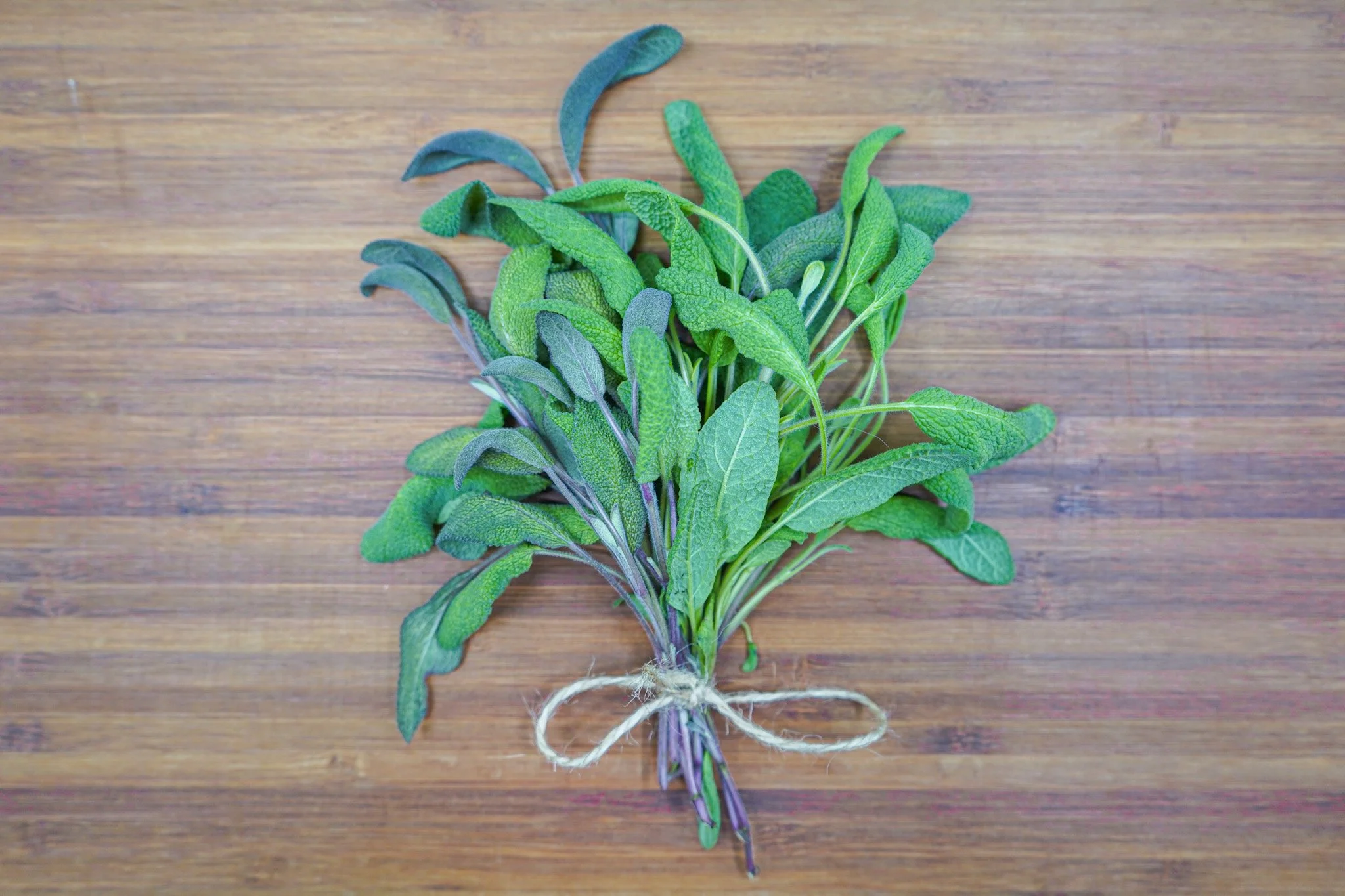Sage
When thinking about food as medicine, we must mention one of the oldest medicinal herbs. Sage’s genus name Salvia means “to save” or “to heal,” which is fitting as it’s been recognized for its health benefits for centuries. Sage has traditionally been used to treat a wide range ailments - from depression to the black plague. And it continues to be intensely studied today for its valuable compounds.
What is Sage?
Sage is the largest member of the mint family with over 900 different species, including common sage, pineapple sage, and clary sage. Its leaves can be green, purple, or gray and are long and fuzzy—little hairs on the leaves’ surfaces store essential oils.
The plant grows pink and purple flowers as it goes to seed. Dried sage tends to be more bitter than fresh, but its overall flavor is warm, earthy, and strong. At our Arlington, Virginia farm, we primarily grow organic purple and green sage varieties for the local community.
Sage’s history as a medicinal herb can be traced across many cultures over thousands of years to heal and increase well-being. The herb has been traditionally used to treat digestive issues, lessen anxiety, remedy sore throats, repel insects, stop excessive sweating, and reverse graying hair.
Its health benefits come from the 28 different compounds that are commonly found in sage—its properties are anti-diabetic, antioxidant, anti-microbial, antispasmodic, antifungal, and antiseptic; these properties lend themselves to the wide range of internal and external uses of sage as medicine.
The lady bugs in the video are part of our Integrated Pest Management (IPM) used at our Arlington, VA farm. You can learn more about our lady bugs here.
Sage’s high concentration of essential oil is significant, as it makes searching for and studying compounds with potential health benefits easier. For example, sage, which has been used traditionally to increase mental clarity, continues to be studied for the treatment of Alzheimer’s - specifically for its ability to inhibit the breakdown of the chemical messenger acetylcholine, which affects memory.
How to Prepare Sage
As a culinary herb, sage is versatile and aromatic. It has a spongy texture when eaten raw, while cooking sage will release its strong aroma. By receiving your herbs from a local, organic source, you can be assured that they are fresh.
Here are some ways to prepare fresh sage:
Seasoning: Rub whole or finely chopped leaves onto meats and vegetables before cooking.
Stuffing: Add chopped sage leaves to bread stuffing.
Infused Oils: Create flavorful infused oils by steeping sage leaves in olive oil.
Herbal Butter: Blend finely chopped sage leaves with softened butter to create a herb butter.
Soups: Add sage leaves to butternut squash soup or bean-based stews.
Herbal Tea: Steep sage leaves in hot water to create a soothing and aromatic herbal tea. Sage tea is believed to have calming properties and can be enjoyed on its own or blended with other herbs.
Sage Health Benefits
Anti-Inflammatory: Sage contains rosmarinic acid and flavonoids. These compounds help reduce inflammation in the body, which may benefit conditions like arthritis and inflammatory bowel diseases.
Antioxidants: Sage contains phenolic compounds and flavonoids, antioxidants that help neutralize harmful free radicals in the body, protecting cells from oxidative stress and potential damage. Antioxidants are also associated with a reduced risk of chronic diseases, including certain types of cancer.
Cognitive Health Support: Sage has been traditionally used to support cognitive function and memory. Studies suggest that sage may have positive effects on brain health, including improved memory and cognitive performance. The compounds in sage, such as rosmarinic acid and triterpenes, are believed to have neuroprotective properties.
Digestive Aid: Sage has been used for centuries as a digestive aid. It contains compounds that can help stimulate digestion, reduce bloating, and relieve gastrointestinal discomfort. Sage tea, in particular, is often consumed after meals to support digestion.
Sage Facts
Medical Clout for Centuries: A Medieval poem shows the belief in sage as a healer. It starts, “Why should a man die in whose garden grows sage?”
Sage Burning: Sage’s antimicrobial status means burning it can literally clear the air. However, “smudging,” the act of burning sage to clear the energy of a space or person used in sacred Indigenous rituals became an insta-trend which led to the overharvesting of white sage in California.
Drought Tolerant: Sage is able to withstand dry conditions, as it grows well in poor, undrained soils.
Area 2 Farms for Locals
Your food should be equally accessible and nutritious. Which is where we come in. We’re Area 2 Farms, we grow organic produce, deliver it to your door weekly, and operate all within 10 miles of you.





